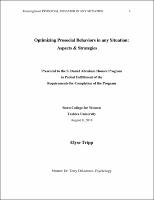Please use this identifier to cite or link to this item:
https://hdl.handle.net/20.500.12202/4513Full metadata record
| DC Field | Value | Language |
|---|---|---|
| dc.contributor.advisor | DiLorenzo, Terry | en_US |
| dc.contributor.author | Tripp, Elyse | |
| dc.date.accessioned | 2019-07-10T18:24:31Z | |
| dc.date.available | 2019-07-10T18:24:31Z | |
| dc.date.issued | 2018-08-08 | |
| dc.identifier.citation | Tripp, Elyse. Optimizing Prosocial Behaviors in any Situation: Aspects & Strategies Presented to the S. Daniel Abraham Honors Program in Partial Fulfillment of the Requirements for Completion of the Program Stern College for Women Yeshiva University August 8, 2018. | en_US |
| dc.identifier.uri | https://hdl.handle.net/20.500.12202/4513 | |
| dc.identifier.uri | https://ezproxy.yu.edu/login?url=https://repository.yu.edu/handle/20.500.12202/4513 | |
| dc.description | The file is restricted for YU community access only. | en_US |
| dc.description.abstract | The present paper examines aspects of a situation which will optimize prosocial behavior in an effort to apply the findings to the real world, in an educational or programming capacity, and how to realistically elicit and optimize prosocial behaviors. It reviews many studies in which prosocial behavior is addressed. It has found that aspects of a situation will which optimize prosocial behavior can be divided and categorized into motivations, groups, similarity and familiarity, distress and need of the recipient, awareness of third parties, and norms. Within each of those overarching categories, many different theories and notions are discussed. Regarding motivations, it is found that specifically internal, and not external motivations elicit prosocial behaviors. Concerning groups, in-group bias increases prosocial behaviors, as does having a goal shared by everyone. When discussing similarity and familiarity, prosocial behavior increases whenever there is a similarity drawn or the recipient is familiar, even through the ‘mere exposure effect.’ On the subject of distress and need of the recipient, it is key to create a personal connection between the giver and the recipient and to understand his distress. As for awareness of third parties, it is found that prosocial behaviors significantly increase in public than in private. And finally, speaking about norms, individuals will follow the social responsibility norm and act prosocially, while fulfilling the reciprocity norm by giving to those that have given to them. This paper aims to contribute a unique compellation of prosocial research specifically regarding aspects of a situation or environment that will elicit the prosocial behaviors from anyone in any situation. This paper, at the same time, takes these findings and applies it to real life strategies and tactics that can be used in a program or educational setting to elicit prosocial behaviors. | en_US |
| dc.description.sponsorship | S. Daniel Abraham Honors Program of Stern College for Women | en_US |
| dc.language.iso | en_US | en_US |
| dc.publisher | Stern College for Women Yeshiva University. | en_US |
| dc.rights | Attribution-NonCommercial-NoDerivs 3.0 United States | * |
| dc.rights.uri | http://creativecommons.org/licenses/by-nc-nd/3.0/us/ | * |
| dc.subject | senior honors thesis | en_US |
| dc.subject | prosocial behaviors | en_US |
| dc.subject | optimizing behaviors | en_US |
| dc.title | Optimizing Prosocial Behaviors in any Situation: Aspects & Strategies. | en_US |
| dc.type | Thesis | en_US |
| Appears in Collections: | S. Daniel Abraham Honors Student Theses | |
Files in This Item:
| File | Description | Size | Format | |
|---|---|---|---|---|
| elyse tripp thesis final.pdf Restricted Access | The file is restricted for YU community access only. | 207.28 kB | Adobe PDF |  View/Open |
This item is licensed under a Creative Commons License

